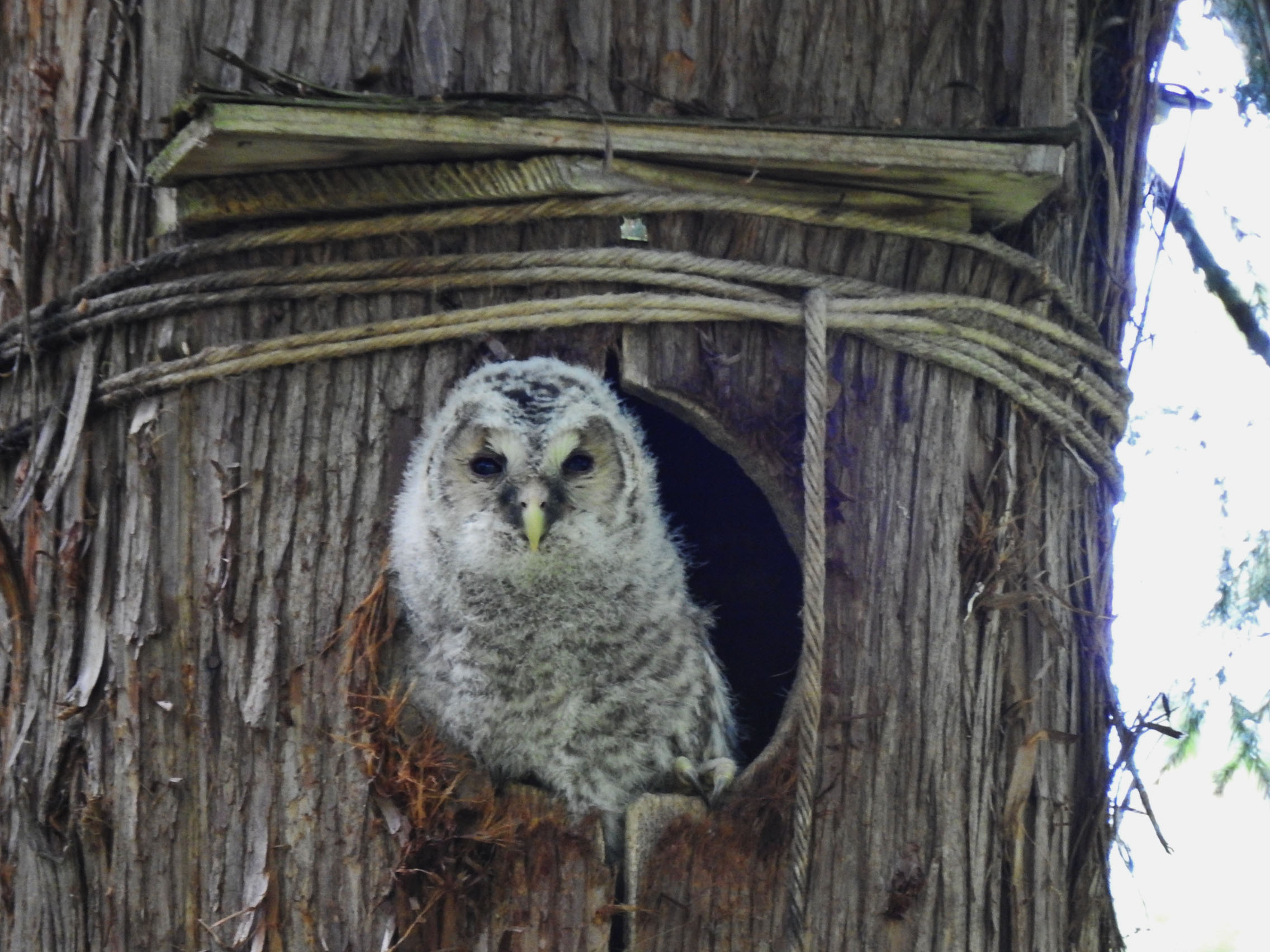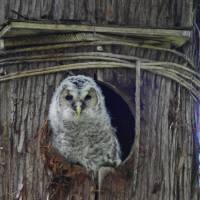The hoot of Japan's most common owl is soft and sonorous, but it can be heard up to 2 km away. When I stay out in the woods at night, with a small campfire and something to sip on, I love to hear the owls calling ... "Ooooo-hoo-hoo." They don't make a lot of noise but when they do give voice, you know about it!
I am reminded of a poem I learned as a boy, which (as far as I recall) goes:
There was an owl who lived in an oak
The more he heard, the less he spoke
The less he spoke the more he heard
Why can't we be like that wise old bird?
Owls (fukuro in Japanese) have fabulous night vision that's estimated to be 35 to 100 times better than ours. Their eyes are enormous, with very wide corneas that allow the maximum amount of light through to the retinas.
Their hearing is also remarkably sharp, though the tufts you see on many owls are not ears, just feathers. Their real ears, which are hidden under plumage, are large and partly covered with flaps of skin. The part of the medulla of the brain concerned with hearing contains some 95,000 nerve cells — more than three times a crow's.
In addition, soft filaments bordering their flight feathers enable owls to fly silently, allowing them to swoop down on unsuspecting prey which, as owls are mostly nocturnal, they probably hunt by both sound and sight.
In 1986, when I began buying up parcels of neglected woodland in Kurohime, northern Nagano Prefecture, we had no owls nesting on our land because the trees were too crowded and scrubby for them to fly among to hunt.
Then, as we trimmed out trees and let light through to the forest floor, it only took a few years for a pair of owls to come in and establish territory. We put up a couple of nest boxes, and one of them, secured to a good strong cedar and about 5 meters above the ground, has been used by a pair of owls ever since.
Normally, owls will nest in the natural hollows of old deciduous trees, but back then we didn't have oaks, beeches, chestnuts and whatnot old and big enough to provide nesting holes. Mixed woods with lots of mice in them surround the cedar I selected for the nest-box site, and the evergreen branches of the cedar provide shelter from the snow in the winter.
Our type of owls, known as Ural owls in English — or by their species name Strix uralensis — are widely distributed across Eurasia, from Scandinavia to South Korea, Japan and Sakhalin. They have a wingspan of about 130 cm, and rounded heads with no "ear" tufts.
Each year, our owls lay two to three eggs, but we've only had them succeed in rearing two young owls a year. It takes 27 to 34 days for the eggs to hatch (we know that because we have a small camera in the nest box), and then about a month before the chicks are ready to leave the nest.
However, the youngsters don't begin to fly and hunt for another two weeks, but instead flap and scrabble from tree to tree with their anxious and very protective parents looking on, ready to fight off any crows, hawks, weasels, martens or foxes.
Parent owls with young have been known to attack humans, but we are very quiet and careful with them and have had no trouble so far. However, 20 years ago, when the "Harry Potter" craze hit Japan, we had to protect the owls' nest boxes from poachers ourselves, because keeping owls became a fad with city types — especially young office ladies. I thought this very strange, as they would probably have had to feed them on frozen mice, mostly from China, which isn't something I imagine most women would enjoy. Moreover, owls definitely do not deliver mail!
But back to reality: While being fed in the nest box, the young owls usually get a mouse or a vole, one a day each. We know that because after the young owls have gone, we salvage everything in the bottom of the nest box to count and analyze the tiny bones left in the pellets they regurgitate, since such indigestible stuff is not passed through the gut. As rodents do a lot of damage to our young trees, particularly in the winter, owls perform a great service for us. Adult owls also eat smaller birds, squirrels and freshwater crabs — though the adults regurgitate outside the nest box or hole.
On May 15, 30 volunteers from our Afan Woodland Trust membership came to Kurohime for a walk around the woods and to help with our annual task of removing and burning the invasive weed from America called cutleaf, (Rudbeckia laciniata). This plant has become very common in Japan and you've probably seen its pretty yellow flowers on roadsides and waste ground. The Environmental Agency tells us to get rid of the stuff, and we do our best, by hand, but we'll never be able to eradicate it entirely.
Actually, on the day of the volunteers' visit I was away for an international fisheries conference in Kobe, followed by a lecture I gave in Osaka, but my employees told me those hardworking folk were absolutely delighted to be able to watch the young owls as they poked their heads out of the nest box. They really are fluffy and cute with their big round eyes and somber, serious demeanor. (I have a Scottish fold cat at home that looks very similar — but she gets alarmed when I forget and hoot at her.)
Of course, we see natural things of free and untamed beauty all the time, which give me great solace — but I get almost as much pleasure when I see city-dwellers experiencing something like a young, wild owl for the first time.
Our experience is that the owls do best when we open up patches in the woods to replant. Before, it didn't matter so much because a short flight away from our woods were several wide areas of open pasture offering ideal habitat for voles. However, in the past decade or so many of these meadows have been neglected and have become overrun with pigweed (Amaranthus palmeri), another invader, so they no longer provide voles with abundant grass, clover and seeds upon which to feed. Also, even if there were a few scurrying around in the jungle, the weeds are up to 3 meters high and far too dense for anything to fly through.
To make things even sadder, when we lost the meadows we lost the larks, too. If we finally raise the funds to build a stable and have our own working horses, I'll have to do something about that.
Meanwhile, the first close encounter I had with an owl was quite terrifying. I was 15 and one early summer evening after school I was among a small group of pupils helping our biology teacher in Britain to catch birds using a mist net strung out from the hedge surrounding a field in order to band them. We were really excited by the numbers of small birds that flew into the net and got entangled, at which point one of us would gently disentangled it while another noted the species, the gender and the number on the leg band we gave it.
It started to get dark, and we were about to untie and fold the net when something really big came flying along the hedgerow just off the ground. Wham! It hit the net and there was an awful, inhuman scream and lots of desperate scrabbling. It was a barn owl — and they are strong! With sharp talons and a wicked curved beak, they are almost impossible to control, especially when they are in a bad temper.
I managed to get a bag over the owl's head and somebody else wrapped it up in a coat, while yet another brave soul bit-by-bit opened the bundle of bird and coat to snip away at the fine mesh with a pair of scissors.
Obviously we ruined the mist net, but we managed to avoid any serious damage to ourselves and were able to let the owl fly off unharmed — but undoubtedly shocked.
Then, just as it disappeared into the dusk, our teacher started cursing because nobody had thought to put a band on it. That was the last time I ever used a mist net to catch birds — and, of course, they are mostly illegal nowadays.




